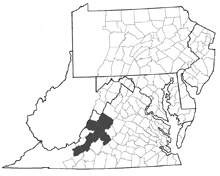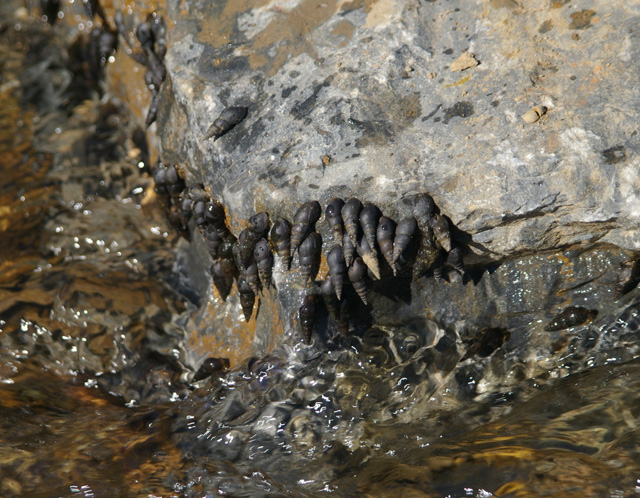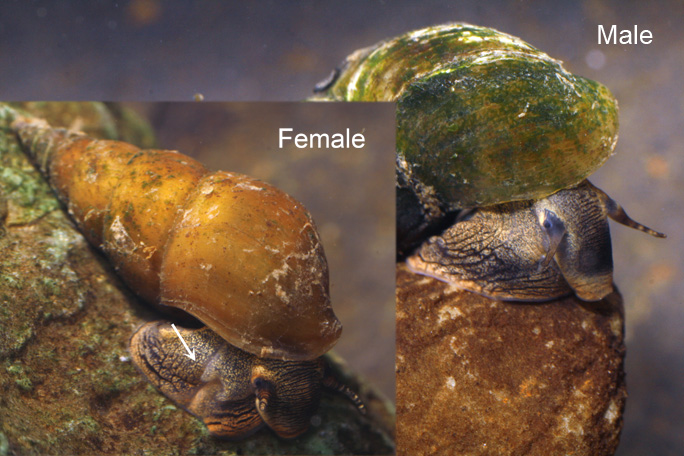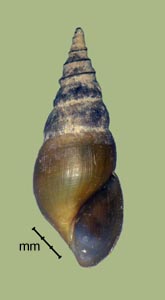Goniobasis or “Elimia” semicarinata
> Habitat & Distribution
The
range of P.
semicarinata (in its typical shell form) as
given by Goodrich (1940) as "tributaries of Ohio River, Scioto River,
Ohio, to Big Blue River, Indiana; Licking River to Salt River in
Kentucky; two creeks of Green River of Kentucky." He
apparently
did not realize that the species extends up the New River drainage into
southern Virginia, down the Blue Ridge scarp to tributaries of the
upper Roanoke River, and then up the Great Valley of Virginia through
tributaries of the James and the Shenandoah. The northernmost
population of P. semicarinata seems to inhabit a small stream in the vicinity of Waynesboro. Throughout this
extensive
range P. semicarinata
inhabits small, rich, hardwater creeks with rocky bottoms and good flow. FWGNA incidence rank I-3p.
> Ecology & Life History
Grazing by populations of pleurocerids can have a significant effect on energy flow in small streams (Dillon 2000: 86 - 91, see also Dillon & Davis 1991).
Like other pleurocerids, P. semicarinata is dioecious, eggs being deposited on hard substrates from spring to mid-summer. Eggs are spirally arranged in masses of 2-15 or more, with a tough, membranous outer covering to which sand grains typically adhere (Smith 1980, Jokinen 1992). Although we are unaware of any study specifically directed toward the life history of P. semicarinata, it seems reasonable to expect that two years will be required for maturity, and that several years of iteroparous reproduction can be expected thereafter, as is the case for pleurocerids generally (Dazo 1965). This is life cycle Hi of Dillon (2000: 156 - 162)
> Taxonomy & Systematics
As is typical for most North American pleurocerids, variability in the shell morphology of P. semicarinata has led to a great number of synonyms. Dillon's (2014) survey of gene frequencies at 11 allozyme-encoding loci returned strong evidence that populations previously identified as P. livescens (Menke 1830) ranging from Wisconsin through northern Indiana and Ohio to Ontario and Vermont are conspecific with P. semicarinata, as are heavily-shelled populations previously referred to Lithasia obovata (Say 1829). More information about this surprising discovery is available from my essay of 11July14, link below.
Three
populations of P.
semicarinata were included
in the allozyme study of Dillon & Davis (1980) - two from
tributaries of the upper New River and one from a tributary of the
North Fork Roanoke. Populations were quite genetically distinct
from populations of P. proxima
and P. simplex,
the two other species that share its range. One of the New River
populations also served as a standard in the allozyme study of Dillon
et al. (2013) and appeared in the mtDNA sequence study of Dillon &
Frankis
(2004).
The karyotype of P. semicarinata livescens sampled from Dazo's (1965) Toma Road Bridge site is 2N = 36 (Dillon 1991). Given the conservative nature of chromosomal evolution in the Pleuroceridae, there is no reason to expect that the karyotypes of typical P. semicarinata semicarinata or P. semicarinata obovata would be any different.
This species has travelled through three genera in thirty years. Although predominantly assigned to Goniobasis through most of the 20th century, in the 1980s many workers began placing it in the resurrected generic nomen, "Elimia." Both Goniobasis and Elimia were subsumed under Pleurocera by Dillon (2011). See my essay of 23Mar11 from the link below for more.
> Supplementary Resources [PDF]
- Pleurocera distribution in Atlantic drainages (2013)
- Virginia species account with county distribution (2011)
- Pleurocera semicarinata in the
headwaters of the North Fork Roanoke River.

- Photomontage comparing male and female P.
semicarinata, highlighting the egglaying groove.
Courtesy of T. Travis Brown.

> Essays
- Taxonomic controversy has surrounded the generic nomina Pleurocera, Goniobasis, and Elimia for many years. The best entry into the subject would be my essay of 23Mar11, entitled Goodbye Goniobasis, Farewell Elimia. Links are available from that essay to older resources.
- On 11July14 I posted an essay elaborating the results of my (2014) paper on cryptic phenotypic plasticity in P. semicarinata, entitled "Elimia livescens and Lithasia obovata are Pleurocera semicarinata." That essay also includes a couple additional figures of extreme shell morphologies.
> References
Dazo, B. C. 1965. The
morphology and natural history of Pleurocera
acuta and Goniobasis
livescens (Gastropoda: Cerithiacea: Pleuroceridae).
Malacologia 3: 1 - 80.
Dillon, R. T. Jr. (1989)
Karyotypic evolution in pleurocerid snails: I. Genomic DNA estimated by
flow cytometry. Malacologia, 31: 197-203.
Dillon, R. T. Jr. (1991) Karyotypic evolution
in pleurocerid snails: II. Pleurocera, Goniobasis, and Juga.
Malacologia 33: 339-344.
Dillon, R. T. Jr. (2014) Cryptic phenotypic plasticity in populations of the North American freshwater gastropod, Pleurocera semicarinata. Zool. Stud. 53:31. [pdf]
Dillon, R. T. Jr., & G. M. Davis (1980) The
Goniobasis
of southern Virginia and northwestern North Carolina: Genetic and shell
morphometric relationships. Malacologia 20: 83-98.
Dillon, R. T. Jr., S. J. Jacquemin & M. Pyron (2013) Cryptic phenotypic plasticity in populations of the freshwater prosobranch snail, Pleurocera canaliculata. Hydrobiologia 709: 117-127. [pdf]
Dillon, R. T. Jr. (2000)
The Ecology of Freshwater Molluscs. Cambridge, Cambridge University
Press. 509 pp.
Dillon, R. T. Jr. (2011) Robust shell phenotype is a local response to stream size in the genus Pleurocera (Rafinesque, 1818). Malacologia 53: 265-277.
Dillon, R. T. Jr., & K. B. Davis (1991)
The diatoms
ingested by freshwater snails: temporal, spatial, and interspecific
variation. Hydrobiologia 210: 233-242.
Dillon, R. T., Jr., & R. C. Frankis (2004) High
levels of mitochondrial DNA sequence divergence in isolated populations
of freshwater snails of the genus Goniobasis
Lea, 1862. Am. Malac. Bull. 19: 69-77.
Goodrich, C. (1940) The
Pleuroceridae of the Ohio River drainage system. Occas. Pprs.
Mus. Zool.
Univ. Mich., 417: 1-21.
Jokinen, E.H. 1992.
The Freshwater Snails (Mollusca: Gastropoda) of New York State. NY
State Mus Bull 482, Albany, New York.
Smith, D.G. 1980.
Goniobasis virginica
Gastropoda Pleuroceridae in the Connecticut River USA. Nautilus
94:50-54.
Stewart, T. W., & R. T. Dillon, Jr. (2004) Species
composition and geographic distribution of Virginia's freshwater
gastropod fauna: A review using historical records. Am.
Malac.
Bull. 19: 79-91.








